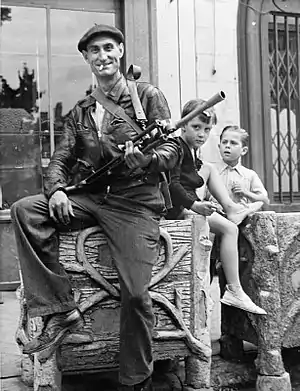法國內務部隊
法國內務部隊(法語:,FFI),也译作法国內地軍 ,是第二次世界大戰後期參與及推動法國抵抗運動的戰鬥組織和游撃隊。其名稱被時任自由法國領導人的夏爾·戴高樂使用作對抵抗納粹德國力量的戰士之正式稱呼。而對這些抵抗力量的正名是發生在法國由德佔軍事管轄區轉變為被同盟國軍隊解放光復之時。在自由法國之下,法國內務部隊較多地被組建為輕型步兵單位並作為自由法國抵抗力量部隊在人力上的補充。相對上,法國內務部隊較多負責駐守或防衛戰線上相對非衝突熱點的位置,並允許正規法軍集中資源並專注攻勢在主要或決定性的方向。1944年8月15日,盟軍發動龍騎兵行動入侵法國南部。1944年10月,隨著絕大部份的法國被解放後,法國內務部隊並併入正規法國第一集團軍之中,並結束了第二次世界大戰中法國非正規軍的時代。
| Forces françaises de l'intérieur 法國內務部隊 | |
|---|---|
 | |
| 存在時期 | 1944–1945 |
| 國家或地區 | |
| 效忠於 | |
| 種類 | 準軍事組織 非正規軍隊 |
| 規模 | 約400,000人 (1944年10月) |
| 駐軍/總部 | 德佔法國軍事管轄區 自由法國 |
| 裝備 | 主要為輕兵器如手槍、衝鋒槍 法製、英製、美製、德製武器 |
| 參與戰役 | 第二次世界大戰 |
| 指挥官 | |
| 著名指揮官 | 馬里-皮埃爾·柯尼希(Marie-Pierre Kœnig) |
解放法國
在1944年6月盟軍執行大君主作戰登陸諾曼第並成功開闢第二戰場後,應法國國民解放委員會的要求,盟軍遠征部隊最高司令部派遣了約200,000名抵抗作戰人員並歸馬里-皮埃爾·柯尼希將軍指揮[1]以統一指揮對抗納粹德國的抵抗力量。時任盟軍最高總司令德懷特·D·艾森豪威爾將軍於1944年6月23日正式確認了柯尼希將軍對法國內務部隊的指揮權。
法國內務部隊主要由使用私人武器的士兵組成,當中亦包括部份前法國士兵。他們主要穿着便服並且佩戴F.F.I.的臂章。
According to General Patton, the rapid advance of his army through France would have been impossible without the fighting aid of the FFI. General Patch estimated that from the time of the Mediterranean landings to the arrival of U.S. troops at Dijon, the help given to the operations by the FFI was equivalent to four full divisions.[2]
FFI units seized bridges, began the liberation of villages and towns as Allied units neared, and collected intelligence on German units in the areas entered by the Allied forces, easing the Allied advance through France in August 1944.[3] According to a volume of the U.S. official history of the war,
In Brittany, southern France, and the area of the Loire and Paris, French Resistance forces greatly aided the pursuit to the Seine in August. Specifically, they supported the Third Army in Brittany and the Seventh U.S. and First French Armies in the southern beachhead and the Rhône valley. In the advance to the Seine, the French Forces of the Interior helped protect the southern flank of the Third Army by interfering with enemy railroad and highway movements and enemy telecommunications, by developing open resistance on as wide a scale as possible, by providing tactical intelligence, by preserving installations of value to the Allied forces, and by mopping up bypassed enemy positions.[4]
參見
- 自由射手和法國游擊隊
- 法國反布爾什維克主義志願軍團 - 維希法國建立的支持納粹德國的協從偽軍民兵組織
- Harrison, Gordon A., Cross-Channel Attack, pages 206–207. Washington DC: Government Printing Office, 1989, and Pogue, Forrest C., The Supreme Command, page 236. Washington DC: Government Printing Office, 1996.
- "Gripe 17" from the 1945 U.S. forces booklet "112 Gripes about the French"
- Blumenson, Martin. Breakout and Pursuit, pages 363–364 and 674. Washington DC: Government Printing Office, 1989. These are only two examples of many cited in this volume.
- Pogue, Forrest C., The Supreme Command, page 238. Washington DC: Government Printing Office, 1996.


